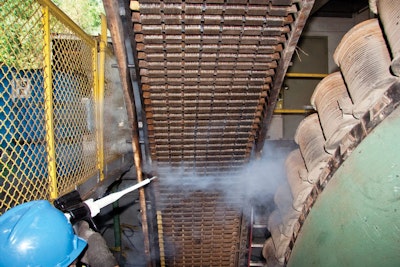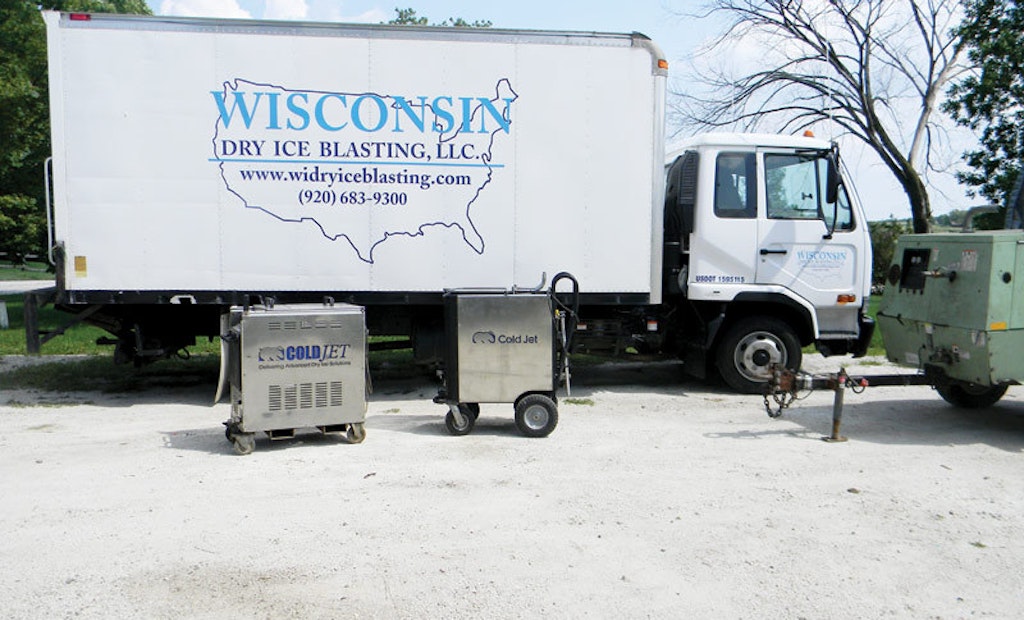Interested in Waterblasting?
Get Waterblasting articles, news and videos right in your inbox! Sign up now.
Waterblasting + Get AlertsAfter years as a painting contractor, a frustrated Jim Wester started looking for a different way to clean sensitive equipment to prepare for priming and top coating. Today he’s out of the painting business completely and instead manages Wisconsin Dry Ice Blasting LLC, an industrial-cleaning outfit located outside Manitowoc, Wis.
Wester’s transition from one career to another illustrates how learning about new technology can take contractors in unexpected directions. But in his case, it only occurred because he was fed up with using chemicals and other means to clean everything from floors and equipment to tanks and interior/exterior walls.
“I figured there had to be a better way to prep surfaces for cleaning,” he recalls. “Working with chemicals or hand-scraping things, trying to get into every nook and cranny, wasn’t that easy. And some chemicals can make you loopy. I sometimes use a 4,000 psi pressure washer, but you can’t use water on most machines. With chemicals and scraping, you can’t get everything clean, but with dry ice blasting, you can.”
Wester’s “aha” moment occurred during an equipment demonstration at a Wisconsin cardboard-manufacturing firm. Cold Jet officials used a dry ice blaster to clean a corrugator machine, and the results blew him away – and left the company’s officials impressed, too.
“They couldn’t believe what it did,” he says. “It was awesome. It cleaned everything and did it easily, too. At that point, I was on a year-to-year contract renewal to handle this company’s painting needs, and they said they’d extend my contract if I bought the machinery.”
Today, Wisconsin Dry Ice owns four Cold Jet units, which clean surfaces by blasting abrasive dry ice pellets under high pressure. The company owns one Aero 75 DX and three Aero 80 HPs (which essentially are next-generation versions of the Aero 75 DX). The Aero 80 HP measures 43 by 20 by 46 inches and weighs 400 pounds. It features an 80-pound-capacity hopper; advanced hopper insulation; blast pressure of 20 to 300 psi; a patented feeder design with a feed rate of up to 7 pounds per minute; trigger-activated hopper agitation; 360-degree radius mobility; and all-terrain, no-flat wheels.
Wester says he uses them in a variety of settings, but mostly to clean ethanol plants, as well as specialty equipment such as hydroelectric motors and gas turbines used by utilities.
“I can honestly say there are very few jobs I’ve walked away from over the years,” says Wester, who established his firm in 2005. The toughest job he faces regularly is cleaning giant 8- to 10-foot-diameter fans in ethanol plants. The chemicals used to make ethanol can eventually cover the fans with up to a 1/2-inch-thick, tar-like coating.
“It takes a lot of work to clean them up, sometimes up to 18 hours for just one fan,” he notes. “But they used to chisel off the coating by hand, a job that could take them days to finish and they didn’t have days to do it – time is money. Plus, when they finished, they had to rebalance the fan blades, which takes a day to do and it’s expensive, too.
“When we’re done, they don’t need to bring in anyone to rebalance them,” he adds. “We get them so clean that they’re balanced the way they were originally. So overall, we significantly reduce their downtime.”
Wester uses just one word to sum up another big advantage offered by dry ice blasting: eco-friendly. Dry ice is nothing more than solid carbon dioxide, a naturally occurring chemical compound that’s a gas at standard temperatures; as such, the pellets propelled by the Cold Jet units evaporate into a harmless trace gas.
“When we’re finished, we leave no secondary waste,” Wester explains. “That’s getting to be a bigger selling point all the time because other [cleaning] media leave a waste, which increases disposal costs for customers. Plus it’s getting harder and harder to find places that will accept some materials, like lead and grease, for example.
“Using water can cause it’s own problems, too,” he continues. “And with sand-blasting, sand gets into everything, no matter how well you protect yourself.”
Moreover, dry ice pellets are abrasive enough to clean thoroughly, but don’t damage the underlying surface of whatever they’re stripping clean.
“Plus we can clean almost anywhere,” he adds. “Take printing presses, for instance. We don’t have to pull the press out of the plant to clean it. As long as no employees are working within 30 or 40 feet from the press, we can clean it safely.”
Wester says he’s never had any trouble selling the concept of using dry ice pellets for cleaning. Some prospective customers are initially wary of the cost, which is higher than conventional cleaning methods (such as sand-blasting, hydroblasting, chemicals and soda-blasting) because of the cost of the dry ice pellets and the fuel needed to run air compressors and so forth. But Wester also notes he can complete jobs much faster.
“Give me a printing press that takes their guys eight hours to clean and we can do it in one hour,” he says.
Like the man said, time is money.







